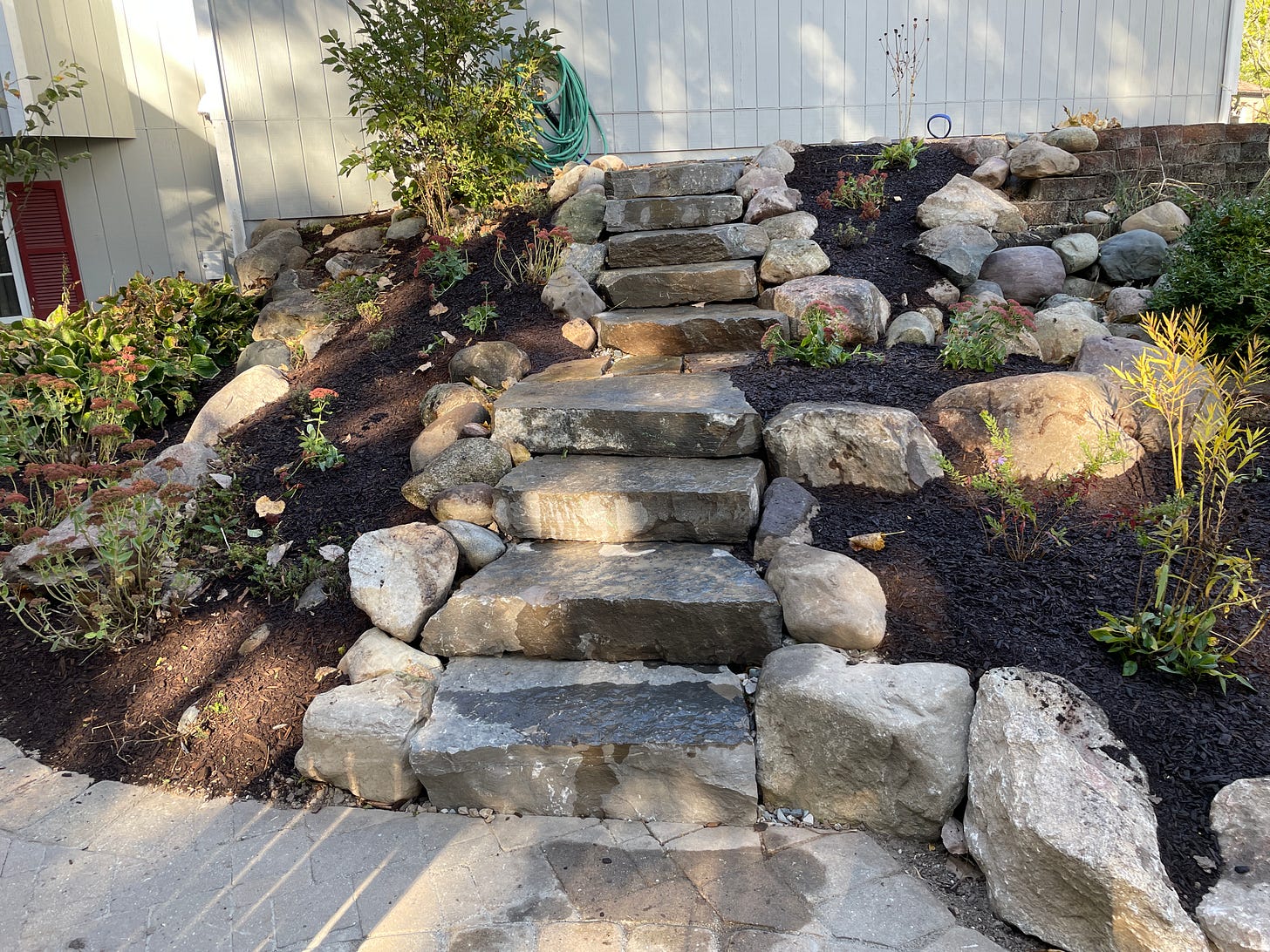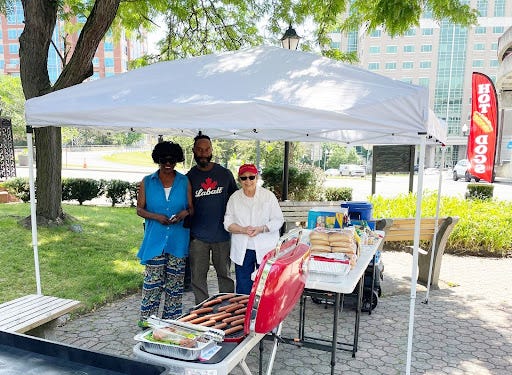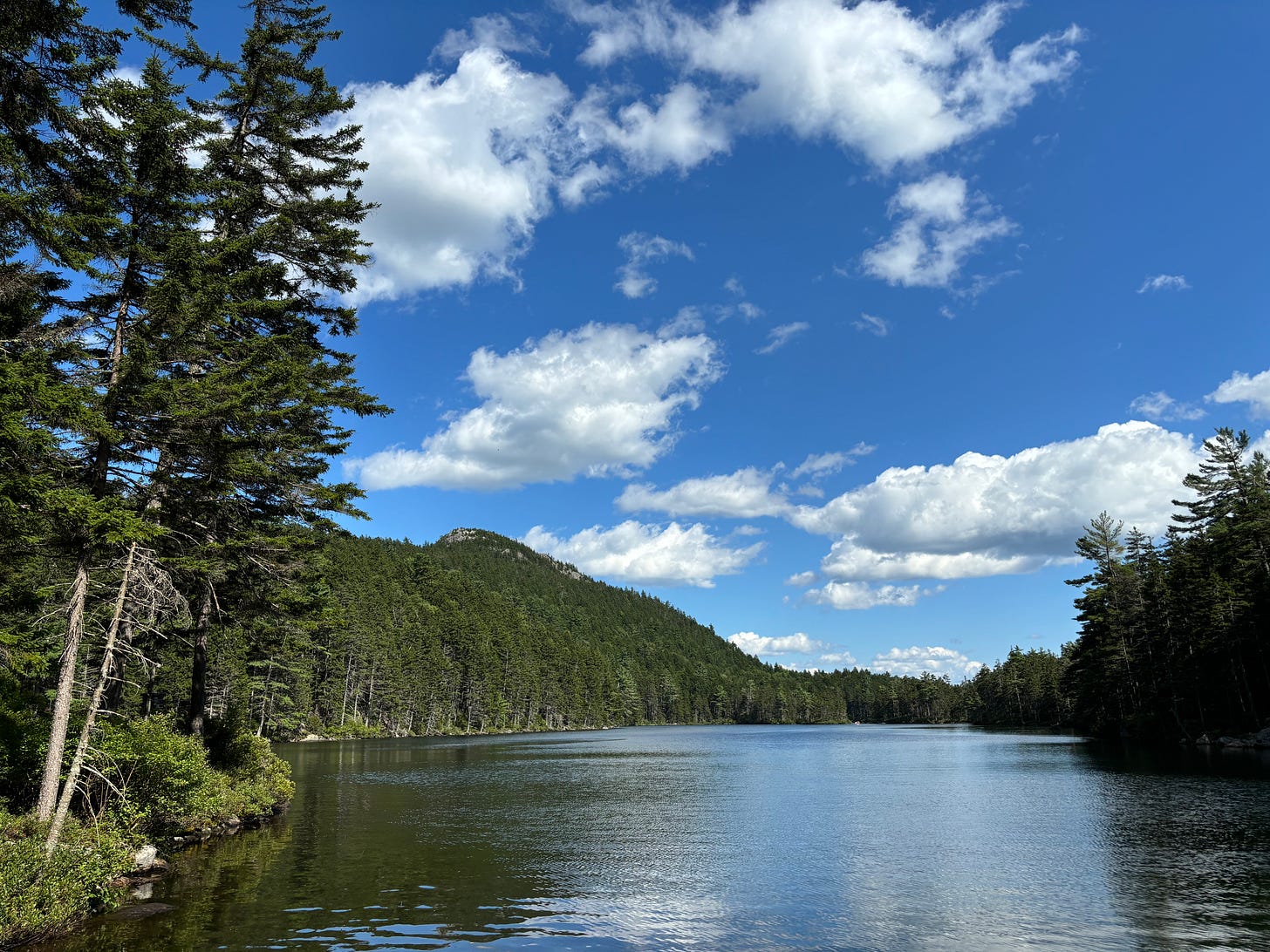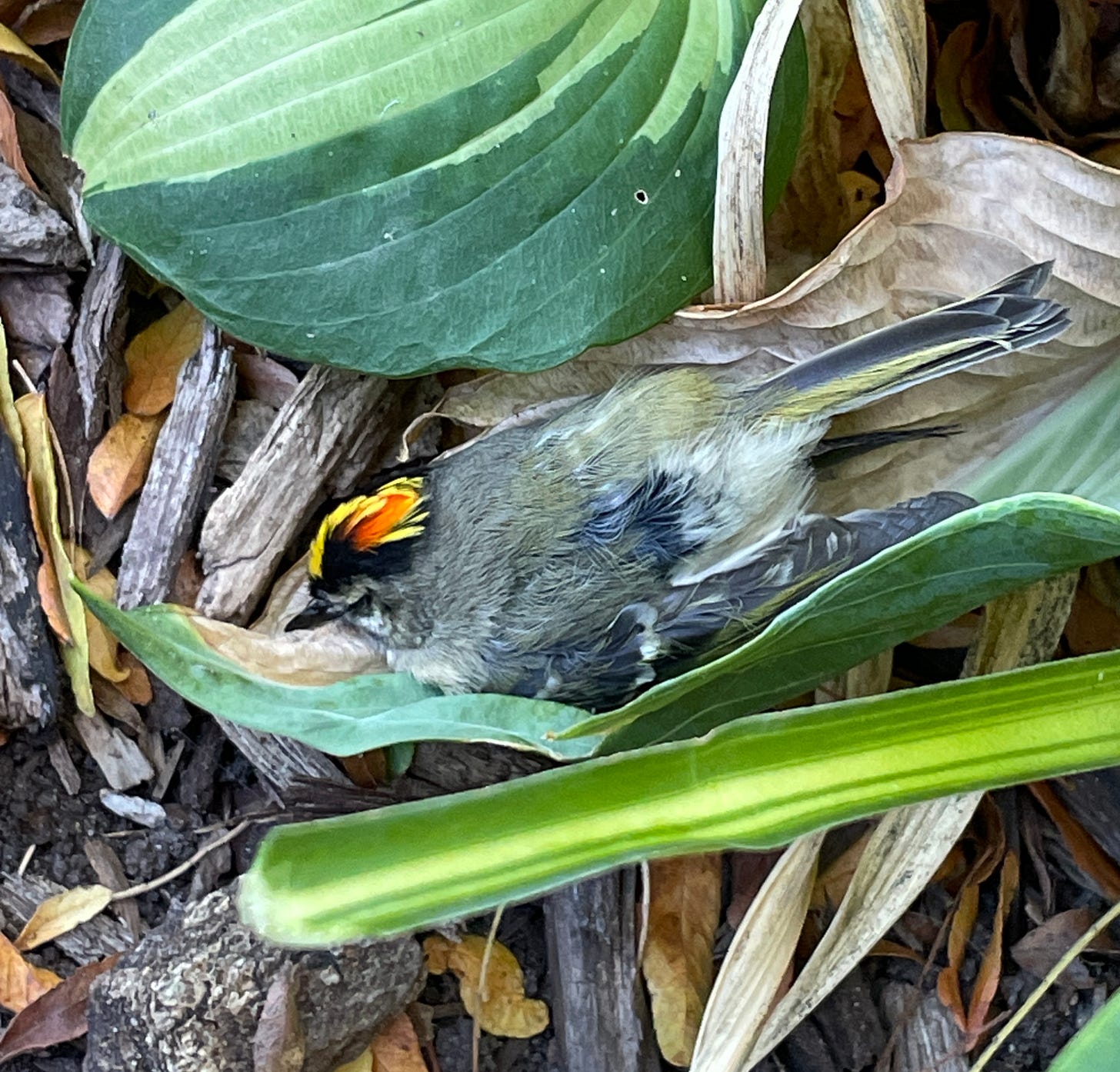Refugia Newsletter #78
Hurricanes, resilience psychology, hot dogs, tofu mousse, and Saturday church
Refugia News
I have only once cancelled a speaking engagement—I had such bad laryngitis that I could not make any sounds at all, let alone speak. This week brought something entirely different: a speaking engagement cancelled because of two hurricanes. I was supposed to travel to Atlanta next weekend, but the organizers cancelled the event at the request of many attendees—who are dealing with the aftermath themselves and also need to look after relatives affected by flooding and dislocation.
The cancellation is no big deal for me of course, up here in perfectly lovely Michigan. And we will reschedule the event for spring. But I have been pondering the strangeness of this new world we live in. After the weather graphics and news headlines, after the heroic rescues, after the cameras and reporters, millions of people must still manage a myriad of long-term repercussions, which radiate out from the actual event and upset lives in unforeseen ways. We’ll address some of these matters below.
Meanwhile, I hereby present yet another native plant area, newly established in my yard. I have said before that native plantings are proving addictive for me and my spouse. We already have two large native plant areas, including a splendid one in the front yard. Well, this summer we had to have some backyard steps rebuilt anyway, so… why not add native planting beds there, too? And how about an area up top for raised garden beds!
No, we did not build all this ourselves. We “paid the man,” as we say.
Here’s the before photo. What a mess! And those steps were a menace. I’m afraid we neglected this area all summer because we had these rebuild plans in the works.
That’s better! Now we won’t break our necks going up and down. Note the tidied-up native plantings. But there’s more…
There we go! That’s our lovely new native planting on the bottom area. There’s nothing like fresh mulch, too, eh? These young plants will grow much larger and more profuse in coming years. For now, you can see the last of this season’s zinnias (I grew them from seed!), too. And you can see part of our rooftop solar array.
Thanks for indulging me. And thanks to Rooks Landscaping for doing the work so well. I can’t wait to see how it grows in spring and how pollinators and birds respond!
Ooo—and here’s something cool I came across this week. A native garden starter kit! Check it out. It comes with a biodegradable template and the plant plugs and everything!
This Week in Climate News
You have of course seen extensive news coverage of Hurricanes Helene and Milton, so I won’t go over all the grim statistics. Instead, I will focus on three themes: attribution science, disinformation, and psychological effects.
Let’s start with attribution science. Is climate change causing hurricanes? Well, that’s not a precisely correct way to put it. Climate change increases the likelihood of big storms and makes them much bigger and more damaging. In the case of hurricanes, winds are stronger, they dump a lot more rain, and they tend to spread a wider path of havoc. They can explode more quickly, too. In Milton’s case, the storm moved from Category 1 to Category 5 in less than 24 hours. How much of a given weather event’s intensity can be attributed to the impacts of climate change can be calculated using a developing field called attribution science.
This brief article by the team at Inside Climate News sums up some of the initial attribution science on the recent double whammy in the Southeast. We know that “Milton was the fifth hurricane to make landfall in the United States and the fifth to strike a Gulf Coast state this hurricane season, which runs from June 1 to November 30.” We also know that “hurricanes are intensifying faster and dropping more rain, and with rising sea levels, tropical storms push tidal waters further inland, making storm surges more dangerous and deadly.”
Bascially, warmer water and air drive bigger, wetter storms. Winds are more extreme, too.
This graphic, showing windspeed probabilities, visualizes the path of the Hurricane Milton and quantifies the deadly winds. Source: NOAA
That same Inside Climate News article put some general numbers on this:
Every 1 degree Celsius of warming increases maximum winds in the strongest storms by about 12 percent, which equates to a 40 percent increase in wind damage, said climate scientist Michael Mann, director of the Center for Science, Sustainability & the Media at the University of Pennsylvania.
“We can expect proportionally larger storm surges, rainfall and flooding,” he said. “One recent study suggests that human-caused warming boosted the Helene-related flooding in the southeastern U.S. by 40 percent.”
A comparable wind prediction map for Helene.
And then there’s the flooding. This article helpfully explains why extreme rainfalls from Helene blasted the inland South with a deluge.
Here’s one snapshot of the rainfall predictions for Helene across the Southeast.
Devastating inland flooding will continue to cause suffering and disruption across the Southeast. All of this will require costly rebuilding, too. Let’s not even talk about how this will affect the insurance situation long term. Another time, OK?
Honestly, my TikTok feed provided the most helpful explanation I’ve seen about the mechanisms by which climate change makes storms worse. This little video might be helpful for teachers and parents to use with kids, too.

 Tiktok failed to load.
Tiktok failed to load.Enable 3rd party cookies or use another browser
Very precise attribution studies take time. Usually what we see is an initial estimate, followed later by the results of more precise modeling.
Finally, though it’s natural to focus on one’s own country’s news, I don’t want to forget that massive rainfall and storm events are wreaking havoc worldwide. This recent New York Times article describes recent devastations all across the globe, also with an eye toward the attribution science that points to how a warming climate balloons these events.
Next: disinformation. Here’s a good article by Zoya Teirstein which originally appeared in Grist and summarizes the nutty conspiracy theories people have been spreading. Ominously, bots might be involved, too. Teirstein writes:
There’s no saying what percentage of these bogus claims [on social media] came from people actually in the areas devastated by Helene, let alone whether humans or bots spewed them. Regardless of who or what wrote them, the conspiracies are patently untrue. FEMA is not confiscating supplies. The Biden administration is not trying to kick people off of land it wants to mine for lithium. And the federal government most certainly cannot control a hurricane. To disaster researchers, the barrage of pointed conspiracies are further proof that conspiratorial thinking is becoming something of an epidemic.
Earlier rumors involved claims that FEMA was only helping certain people, or did not have enough money. Teirstein’s article fairly accounts both for FEMA’s actual role and for reasons why people may legitimately get frustrated:
Many people believe [FEMA] descends on a location with cases of water and pallets of food and armies of people with shovels and flashlights immediately after a disaster. But it is better described as a logistics coordination and check-writing organization. …
One of its primary roles is to coordinate relief efforts and supply distribution with local and state officials and nonprofit agencies. FEMA typically discourages people from sending supplies or going into a disaster zone, not because it wants to keep aid from the people who need it, but because all those items and untrained volunteers simply get in the way and slow down relief efforts. That’s why states often echo FEMA’s calls to stay out of harm’s way and leave recovery efforts to those who know what they’re doing.
Here’s another good explainer about FEMA’s role. In addition, CNN’s Daniel Dale fact-checked all the politically motivated lies spewing from Trump and his surrogates. Meanwhile, some poor staffers at FEMA have apparently been busy putting together a “no it’s not true” rumor response site.
All this in the context of elected officials who engage in irresponsible climate denial. This scathing piece by Kathy Baughman McCleod in Heated observes that this past May, “Florida Governor Ron DeSantis signed a bill removing consideration of climate change from all state laws. The law also nullified the state’s clean energy goals, and banned the construction of offshore wind. ‘I’m not a global warming person,’ DeSantis said, as if accepting reality were a personal choice.”
Misinformation, disinformation, and climate denial are all dangerous. False rumors about hurricane response can impede actual assistance efforts. All lies and denials degrade our public discourse and train people to believe nothing—that’s the power of denial and lies.
Thus, blessings be upon people who seek the truth with integrity and care. And hooray for Florida meteorlogist John Morales, who covered the hurricane with skill but also so much human feeling that he had to hold it together on air. He said the words, too: he named climate change. The video went viral. It’s worth watching.
Deeper Dive
For our Deeper Dive today, I want to share an article on disaster resilience psychology. Written by columnist Bob Doppelt, the article appeared this week in Psychology Today. Doppelt leads the International Transformational Resilience Coalition (ITRC), “a network of mental health, social service, disaster management, climate, and faith organizations and professionals.” Here’s his opening statement in the article:
Everyone must be prepared for what is speeding their way, and the best way to do this is to establish permanent “resilience coordinating networks” in neighborhoods and communities across the U.S. and worldwide.
Doppelt then goes on to outline recognized stages of experiencing a disaster. First, there’s the “pre-disaster” phase, characterized understandably by a lot of fear—or perhaps denial. The next phase is the “heroic” phase, where people often respond very generously. They help neighbors, they pitch in to assist in shelters, they feed each other. Communities step up and come together during this “community cohesion phase.”
I learned more about the social science around altruistic responses to disasters from Rebecca Solnit’s fascinating book A Paradise Built in Hell, in which she examines numerous historic disasters and the social science around people’s response. We are often led to believe that people panic, lose their minds, fend for themselves, and turn savage. That is not what the social science says, however. Most (not all!) people actually rise to the occasion. I highly recommend the book.
Doppelt seems to confirm Solnit’s observations about those early stages. Then, according to Doppelt, the community cohesion phase winds down, maybe in about a month or so. And then we hit the “disillusionment” stage. People are worn down, discouraged, and ready to go back to a normal they will never find again. “It is during this lengthy period of dismay that most mental health and psychosocial problems will likely appear,” writes Doppelt.
Because more of us can expect to endure more disasters in the future, we need to mitigate the potential psychological effects by building ongoing “resilience coordinating networks.” Doppelt writes: “This requires establishing and maintaining for decades to come the ‘social infrastructure’ in neighborhoods and communities that builds and sustains the mutual aid and emotional support that emerges during the ‘community cohesion’ phase of disasters.”
That sounds like the refugia work, the kind to which faith communities are gifted to contribute. That leads to our next segment…
Refugia Sightings
Three lovely examples today of faith communities doing exactly that kind of social-fabric-building work. My friends at the BTS Center like to encourage faith groups to engage in “small experiments with radical intent.” I love that phrase. It captures the significance of small steps, but also urges radical thinking toward larger effects. Here are illustrative examples.
Hot dogs knit community. Rev. Trey Tirpak recently described a simple experiment that turned—in his words—beautiful. First Church in Albany, New York, is a downtown church surrounded by “different neighborhoods, businesses, government offices, and schools.” Every Thursday afternoon in the summer, writes Trey, “First Church volunteers fire up a grill and hand out free hot dogs, literally as fast as they can.” Last summer, he writes, “by the end of August, they were passing out close to 200 dogs each Thursday.”
The church’s plan started out simple, but then volunteers started asking, “how can we make this more beautiful.” They started adding fancy condiments, chips, popsicles for kids, water misters, prayer shawls, and more. Eventually, this simple idea became a space where social fabric gets knitted together:
And then there’s the beautiful cross-section of people who come and mingle as they eat: government officials and court workers, engineers and school teachers, retired veterans and kids off for the summer, even tourists and neighbors who live outside. I’ve witnessed our volunteers get to know people by name and check up on their sick family members, people praying for one another, and moms setting up play times for their kids. Some folks only know each other from meeting at Hot Dogs in the Park! Others inquire about church and even come to worship. I had a community member tell me he hates church and then hand me cash as a donation to our church because he loves this ministry so much.
Photo credit: Colleen Lais
Go plant-based together. My friend Lee Hardy sent me a little folder with recipes gathered by a small group in his church, Eastern Avenue Church in Grand Rapids, Michigan. The group decided that they should work toward a plant-based diet, based on Project Drawdown research about the climate benefits of eating less meat. Wouldn’t it be more fun work on plant-based eating together? So they started meeting for potluck dinners and experimenting with plant-based recipes. And then they gathered all their favorites into a little pamphlet. Lee assures me that “Silken Tofu Chocolate Mousse” is especially good.
Ministry to the unhoused becomes “Saturday church.” This one involves food, too. A new friend that I met at the BTS Center Convocation, Scott Klinger, sent me a beautiful description of a community ministry to the unhoused in Augusta, Maine, that has blossomed in unexpected ways. I won’t explain all the details, but Scott’s story is a great example of several community partners working together, including a local shelter, a Congregational church, a Unitarian Universalist church, and the YMCA. Besides providing shelter and showers for unhoused neighbors, this ministry established a Saturday breakfast that has become a beloved time for “guests” and “hosts,” to the point where the line between the groups gets happily blurred.
Scott writes:
The Saturday breakfasts started as a traditional haves helping have-nots, but quickly became much more than that. We've always operated on a principle of abundance, serving food buffet style, allowing people to take what they want and as much as they want. The area soup kitchen practices strict portion control and only one trip through the line. They also make people leave their packs and shopping carts outside and prohibit dogs. The Saturday breakfast has indoor space for people's belongings and welcomes pets in the breakfast room.
We average 65 neighbors a week eating and it is not always easy to distinguish between the volunteers and the guests. Many unhoused people have taken leadership over setting up and sometimes cooking. If there are spills or dog accidents, the guests are always quick to clean up.
Scott says people have been calling this time “Saturday church,” and he observes that this is what refugia looks like. Yes!
Photo Corner
One more reference to the BTS Center today. (You can tell I’m still glowing from my trip out there two weeks ago.) A big thank-you to Ben Yosua-Davis, Allen Ewing-Merrill, and whole BTS staff for linking to this newsletter in their newsletter. Substack tells me I gained about 40 new subscribers in the last few weeks. Wow! Welcome to all new subscribers!
As a thank-you to Ben and Allen, I share this gorgeous photo Allen sent me of a favorite spot. He writes: “This is Midday Pond and Borestone Mountain in Elliotsville, Maine — a beautiful Audubon Sanctuary near the southern end of Maine’s 100-mile wilderness and a place of deep family roots.’
Photo credit: Allen-Ewing Merrill
I leave you with this photo I took on my university’s campus last week. Some students noticed this tiny golden-crowned kinglet already dead on the sidewalk. A passing student and I tried to give the little thing a proper resting place. I think the photo turned out rather poignant.
What a delicate, beautiful creature. When I carefully picked it up, it weighed nothing—like air itself.
Until next time, I hope you are safe and well.
As always, bold type in quotations is added, unless otherwise indicated.















Debra, what a delight it was to meet you at the BTS Convocation recently! And thank you for writing up our Saturday breakfast in this newsletter! I will pass it on to the other people who help at the breakfast. Scott Klinger is a good friend.
Blessings to you!